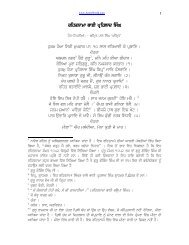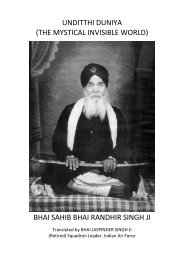Guru Gobind Singh's Death at Nanded Examination of - Vidhia.com
Guru Gobind Singh's Death at Nanded Examination of - Vidhia.com
Guru Gobind Singh's Death at Nanded Examination of - Vidhia.com
You also want an ePaper? Increase the reach of your titles
YUMPU automatically turns print PDFs into web optimized ePapers that Google loves.
k<br />
10 AN EXAMINATION OF SUCCESSION THEORIES GURU GOBIND SINGH S DEATH AT NANDED 11<br />
oppression, ready to lay down his life in their cause, if need<br />
be. This was <strong>Guru</strong> <strong>Gobind</strong> Singh, both a teacher and a disciple—<br />
the real Khalsa—a saint and a soldier, a man <strong>of</strong> the<br />
world and yet detached.<br />
As the son <strong>of</strong> a martyred f<strong>at</strong>her, he was the target <strong>of</strong><br />
the <strong>at</strong>tention <strong>of</strong> both the oppressed people and <strong>of</strong> the oppressive<br />
rulers. While his people looked up to him as their<br />
saviour and socio-political guide, the power-mad rulers looked<br />
upon him as a dangerous enemy who was inspiring their meek<br />
and submissive subjects with a spirit <strong>of</strong> freedom and resistance.<br />
The l<strong>at</strong>ter, therefore, were ever w<strong>at</strong>chful <strong>of</strong> his programmes and<br />
vigilant <strong>of</strong> his activities.<br />
As a scholar <strong>of</strong> many languages and a writer <strong>of</strong> soulstirring<br />
poetry, practising the use <strong>of</strong> arms and training his men<br />
in it, he always acted in the open and kept himself in close<br />
and constant touch with those around him. As a <strong>com</strong>mander<br />
<strong>of</strong> his armies fighting either against the Hill Rajas <strong>of</strong> the<br />
Sivalaks or Mughal levies <strong>of</strong> Sirhind and Lahore, he always<br />
occupied a prominent place within the sight <strong>of</strong> his men.<br />
Those were the days when it was darshan <strong>of</strong> the leader th<strong>at</strong><br />
inspired and sustained them in the field <strong>of</strong> action. He<br />
cre<strong>at</strong>ed out <strong>of</strong> the indistinguishable <strong>com</strong>mon people the<br />
distinct order <strong>of</strong> the Khalsa, with an un<strong>com</strong>mon form and<br />
symbols th<strong>at</strong> helped distinguish them easily in a crowd <strong>of</strong><br />
millions.<br />
It was only on one occasion—the only one known to<br />
history—after the b<strong>at</strong>tle <strong>of</strong> Chamkaur th<strong>at</strong> he had to disguise<br />
himself, as the tradition goes, to avoid being <strong>at</strong>tacked <strong>at</strong> night<br />
and falling into the hands <strong>of</strong> the enemy who had broken his<br />
vow. A soldier, a brave and determined soldier, has to take<br />
all possible precautions to protect and save himself for the<br />
ultim<strong>at</strong>e object <strong>of</strong> his struggle. He has to so dress himself or<br />
to adopt such a style <strong>of</strong> <strong>at</strong>tire, or guise or external appearance<br />
as to avoid being recognized by the enemy and be<strong>com</strong>ing an<br />
easy target <strong>of</strong> his bomb or bullet or falling into his hands.<br />
It is with this object in view th<strong>at</strong> Khaki drill was used for the<br />
dress <strong>of</strong> the Indian army in the sun-burnt brownish lands and<br />
was changed into olive green for use in the greenish jungles.<br />
It was also under similar circumstances and for a<br />
similar purpose in an exigency <strong>of</strong> war th<strong>at</strong> <strong>Guru</strong> <strong>Gobind</strong> Singh,<br />
after his successful escape from the siege <strong>of</strong> Chamkaur, accepted<br />
the shelter <strong>of</strong> Ghani Khan and Nabi Khan, the P<strong>at</strong>han<br />
brothers <strong>of</strong> Machhiwara, and adopted, in response to their<br />
request, the blue dress <strong>of</strong> the venerable Pir <strong>of</strong> Uch. It was<br />
a part <strong>of</strong> tactics in an emergency during his war with Wazir<br />
Khan, the faujdar <strong>of</strong> Sirhind. It was a temporary precaution<br />
for his safety in ap<strong>at</strong>-kal—time <strong>of</strong> adversity—as an old authority<br />
put it. And there was nothing wrong or derog<strong>at</strong>ory in it.<br />
As soon as he was out <strong>of</strong> the reach <strong>of</strong> his pursuers, he cast<br />
his blue dress away and was up and doing again in rallying<br />
his sc<strong>at</strong>tered followers and fighting the b<strong>at</strong>tle <strong>of</strong> Muktsar.<br />
The <strong>Guru</strong> knew no despondency and did not give way<br />
to frustr<strong>at</strong>ion even under the most adverse circumstances. He<br />
lost not his heart <strong>at</strong> the de<strong>at</strong>hs <strong>of</strong> his four young sons and his<br />
aged mother. Two <strong>of</strong> his sons he had himself sent into<br />
the field <strong>of</strong> b<strong>at</strong>tle <strong>at</strong> Chamkaur. He heard the news <strong>of</strong> the<br />
cold-blooded murder <strong>of</strong> his younger sons <strong>at</strong> Sirhind with<br />
<strong>com</strong>plete resign<strong>at</strong>ion to the Will <strong>of</strong> God. His letter addressed<br />
to Emperor Aurangzeb from Dina, populary known as the<br />
Zafar Namah or Epistle <strong>of</strong> Victory, evidently in reply to one<br />
from the Emperor, speaks —through its style and content—<br />
volumes for the undisturbed and ever calm st<strong>at</strong>e <strong>of</strong> his mind.<br />
With the cess<strong>at</strong>ion <strong>of</strong> war, evidently, under royal orders,<br />
<strong>Guru</strong> <strong>Gobind</strong> Singh again engaged himself in literary pursuits<br />
and <strong>com</strong>pleted and edited the Sikh holy book <strong>at</strong> Talwandi<br />
Sabo, now known as Damdama Sahib, in the Bh<strong>at</strong>inda<br />
district.<br />
2. HIS LAST DAYS<br />
Forgetful <strong>of</strong> the long standing animosity and continued<br />
persecution by the Mughal emperors, the <strong>Guru</strong> favourably<br />
responded to the invit<strong>at</strong>ion <strong>of</strong> Aurangezeb for a meeting and<br />
set out for the Deccan where the Emperor then lay encamped.<br />
But the Emperor died on February 20, 1707, while the <strong>Guru</strong><br />
was on his way to the south. He received the news near




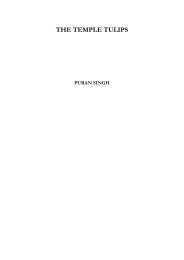
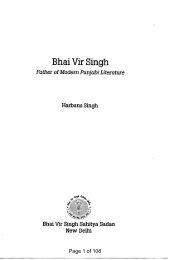

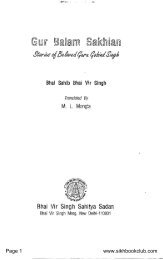
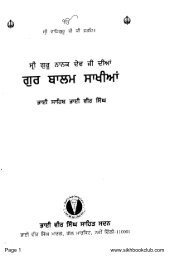
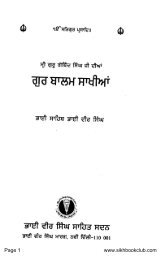
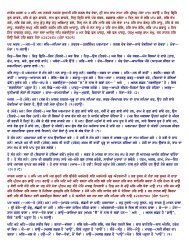
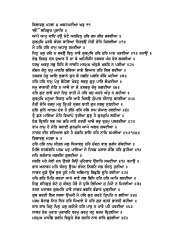

![cOpeI ] hmrI kro hwQ dY r~Cw ] pUrn hoie ic~q kI ie ... - Vidhia.com](https://img.yumpu.com/12240258/1/190x245/copei-hmri-kro-hwq-dy-rcw-purn-hoie-icq-ki-ie-vidhiacom.jpg?quality=85)
